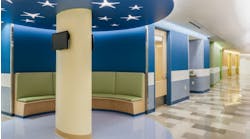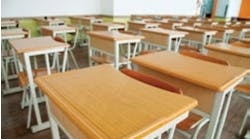Nearly five years ago, the American National Standards Institute (ANSI) approved guidelines for acoustics in school facilities. The guidelines are not mandatory in most jurisdictions, but they provide strategies for creating learning spaces where students can effectively comprehend what teachers and fellow students are saying.
Some states and local districts have used the ANSI standards as a basis for putting together their own guides for achieving good acoustics. In 2006, the Maryland Department of Education published a 42-page guide to help schools in the state provide proper classroom acoustics.
“School facilities should be sited and designed to isolate inside learning spaces from outdoor transportation noise sources,” the guide says. “Architectural designers must consciously locate noisy spaces and activities within the school to protect sensitive learning spaces.”
The guide offers tips for incorporating good acoustics in school construction:
-
Architects, building contractors, a school system's design staff, equipment suppliers and professionals with experience in noise-control technology should coordinate their efforts.
-
Specify sound-insulating windows to block street noise or other environmental noises.
-
For lecture-type classrooms, ring the upper wall and ceiling with sound-absorbing material. In lecture halls, use sound-reflecting material over the lectern and sound-absorbing upholstered chairs.
-
For classrooms with no fixed lecture position and a ceiling less than 3 meters high, place most if not all sound-absorbing material on the ceiling. For ceilings higher than 3 meters, an increasing amount of absorbing material will have to be on walls.
-
Stagger room entrances along corridors to reduce direct sound transmission through open doors.
-
Avoid fluorescent lighting with ballasts that emit a constant hum.
-
Choose a central HVAC system that places noisy fans and compressors away from classrooms and delivers air at a low velocity.
-
Consider sound-monitoring equipment and training to detect and respond to problems.
The guide notes that although plumbing noise is not measured as background noise for the purpose of the ANSI standard, it still is worthwhile to take steps to reduce noise generated from a plumbing system:
-
Run plumbing pipes above corridor ceilings, not above learning spaces.
-
Use cast-iron wastewater pipes when possible; wrap plastic piping with one or more layers of sound-attenuating material.
-
Make sure plumbing installations meet noise-control standards before sealing the walls.
The Maryland guide is online at www.marylandpublicschools.org/NR/rdonlyres/FCB60C1D-6CC2-4270-BDAA-153D67247324/10128/ClassroomAcousticsGuidelines.pdf.
NOTABLE
35
In decibels, recommended maximum background noise for a typical classroom.
40
In decibels, recommended maximum background noise for ancillary learning spaces (e.g., media centers, technology labs, cafeterias).
Source: American National Standards Institute Acoustical Performance Criteria, Design Requirements and Guidelines for Schools.

